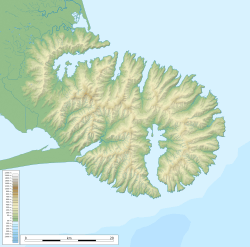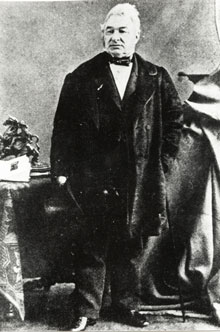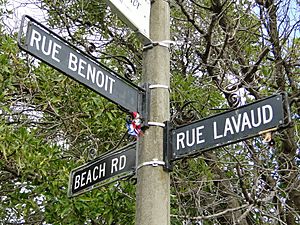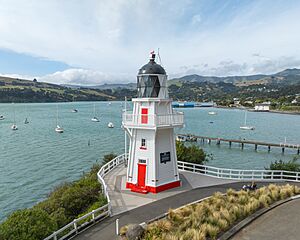Akaroa facts for kids
Quick facts for kids
Akaroa
|
|
|---|---|
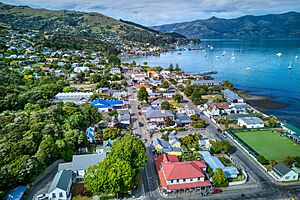
Akaroa township and main wharf in 2024
|
|
| Country | New Zealand |
| Region | Canterbury Region |
| District | Christchurch City |
| Ward | Banks Peninsula |
| Community | Te Pātaka o Rākaihautū Banks Peninsula |
| European settlement | 18 August 1840 |
| Founded by | Jean François Langlois |
| Electorates |
|
| Area | |
| • Total | 2.03 km2 (0.78 sq mi) |
| Population
(June 2023)
|
|
| • Total | 770 |
| • Density | 379/km2 (982/sq mi) |
| Postcode |
7520
|
| Local iwi | Ngāi Tahu |
Akaroa is a small town located on Banks Peninsula in the Canterbury Region of New Zealand's South Island. It sits within a harbour that shares its name. The name Akaroa comes from the Ngāi Tahu Māori words for "Long Harbour." In standard Māori, this would be spelled Whangaroa. French settlers also called the area Port Louis-Philippe after the French king Louis Philippe I.
The town is about 84 kilometers (52 miles) by road from Christchurch. It is at the end of State Highway 75. Akaroa is nestled in a calm harbour, surrounded by the remains of an ancient volcano called the Banks Peninsula Volcano.
Contents
History of Akaroa
In 1830, a significant event happened at Takapūneke, a Māori settlement near Akaroa. The captain of a British ship, John Stewart, helped a North Island chief, Te Rauparaha, capture the local Kāi Tahu chief, Tama-i-hara-nui. This led to many people being killed or taken as slaves. This event was one of several lawless acts by Europeans in New Zealand. These actions led to the British government appointing an official British Resident, James Busby, in 1832 to help bring order.
The local population was further reduced in 1832. This happened when Te Rauparaha attacked and took over the pā (fortified village) on Ōnawe Peninsula in Akaroa Harbour.
Early European settlers used Akaroa as a base for whaling. Today, Akaroa is one of the few former whaling bases in New Zealand that still exists as a town.
French Settlement in Akaroa
In the 1830s, France planned to expand its colonies, including in the Pacific. In 1838, a whaler named Captain Jean François Langlois claimed to buy a large part of Banks Peninsula from twelve Kāi Tahu chiefs. He paid a small deposit and promised more later.
Langlois then raised money from rich businessmen in France to start a whaling and colonizing company called the Nanto-Bordelaise Company. He gave his claim to the land to this company.
The French government supported this plan. They sent a warship, the Mahé (renamed Comte de Paris), with 63 settlers. Another warship, the Aube, led by Commodore Charles-François Lavaud, went with them. Their goal was to oversee French whaling and settlement in New Zealand.
The ships arrived in the Bay of Islands on July 11, 1840. There, they learned that William Hobson had already declared British control over all of New Zealand on May 21. Also, many Māori chiefs in the South Island had signed the Treaty of Waitangi. To make sure there was no doubt about British rule, Hobson sent the ship HMS Britomart to Akaroa. This ship arrived before the French settlers to show that the British were in charge.
On August 18, 1840, the French settlement in Akaroa began. There were 57 settlers, including 12 Germans. For the first six years, many French sailors and naval officers lived there. They created a French community with missionaries, churches, a hospital, and even a French court. The area still has a French feel, with many street names in French. Akaroa is the oldest town in Canterbury and has a rich history in New Zealand.
The British government did not accept the French company's land claim. After long talks, the British decided to grant 30,000 acres to the Nanto-Bordelaise Company in 1845. However, this land was never clearly defined. The company faced financial problems and sold its land to the New Zealand Company before going out of business in 1849. By then, the French settlers were living in a British colony.
Before 1840, the area of Akaroa was also known as Wangaloa. The French first named their settlement Port Louis-Philippe to honor Louis Philippe I, the King of the French.
British Settlement in Akaroa
When the British learned about the French plans for Akaroa, Lieutenant-Governor William Hobson sent the ship HMS Britomart. Its mission was to claim the area for the British Crown. HMS Britomart arrived in Akaroa on August 16, 1840. Captain Stanley raised the British flag and held court to show the French that the area was under British control. A monument in Akaroa remembers this British arrival.
James Robinson Clough, also known as Jimmy Robinson, had arrived in Akaroa earlier. He helped Captain Owen Stanley as an interpreter when the flag was raised in 1840. He was also the first European to travel up the Avon River / Ōtākaro in 1843. Clough's family is still well-known on the Peninsula today.
British immigrants settled in Akaroa and German Bay (Takamatua). Many German farmers also arrived, starting dairy, sheep, and cocksfoot farms. The Akaroa Museum has many items from these early farming communities.
In April 1850, the ship Monarch arrived in Akaroa Harbour needing repairs. It was heading to Auckland, but forty passengers decided to stay in Akaroa. These British immigrants settled at the southern end of Akaroa. The French lived at the northern end, with a small bay between them.
In 1854, Akaroa was described as being "very like a small seaside village in England." By 1878, only ten French-born people lived in Akaroa town, out of a population of 642.
Businesses grew in Akaroa. By 1883, there were many shops and services, including builders, general stores, and shoemakers.
Daly's wharf was built between 1863 and 1865 and was updated in 1914. It was used by coastal ships and fishing boats. An octagonal building with a turret roof was added to the end of the wharf by 1932.
In 1903, Akaroa was called a "long favourite holiday haven" for people from New Zealand, Australia, and Europe. Most of Akaroa was along the waterfront then, with few houses on the hillsides. In 1901, Akaroa had 559 people and 124 houses.
The main wharf in Akaroa was built in 1887. Plans were made in 2022 to rebuild it in the same spot, as it was getting old. The rebuild is expected to cost $19.1 million and be finished by June 30, 2025.
Population and People
Akaroa is a rural settlement covering 2.03 square kilometers (0.78 sq mi). As of July 2025, it has an estimated population of 770.
| Historical population | ||
|---|---|---|
| Year | Pop. | ±% p.a. |
| 2006 | 591 | — |
| 2013 | 645 | +1.26% |
| 2018 | 756 | +3.23% |
In the 2018 New Zealand census, Akaroa had 756 people. This was an increase of 111 people (17.2%) since the 2013 census. There were 288 households, with slightly more females than males. The average age was 55.3 years, which is older than the national average.
Most people in Akaroa (82.5%) are European/Pākehā. Other groups include Māori (6.0%), Asian (11.9%), and others. About 34.9% of people were born overseas.
Regarding religion, 44.4% of people said they had no religion. About 34.9% were Christian. Other religions included Hindu, Muslim, and Buddhist.
For those aged 15 and older, 18.2% had a bachelor's degree or higher. The average income was $31,800, similar to the national average. About 47.2% of people aged 15 and over worked full-time.
Tourism in Akaroa
Akaroa is a very popular place for holidays. Many Hector's dolphins live in the harbour, especially near the Akaroa Marine Reserve. Boat tours to swim with these dolphins are a big attraction.
Akaroa became a popular stop for cruise ships after the 2011 Canterbury Earthquakes damaged the port of Lyttelton. In the summer of 2009–10, seven cruise ships visited. This number grew to ninety ships in 2019 and 2020. With the new cruise ship berth opening in Lyttelton, the number of ships visiting Akaroa decreased to 19 in 2022.
Education in Akaroa
Akaroa's first primary school opened in 1857. The first high school opened in 1883, initially for boys, but became co-educational the next year. It closed in 1900 due to a lack of students but reopened as a free District High School in 1901. In 1935, it moved to its current location. In 2007, the primary school joined with the high school to form Akaroa Area School. This school teaches students from Year 1 to Year 13. As of July 2025, it has a roll of 111 students.
Akaroa Museum
The Akaroa Museum opened in 1964. It focuses on the history of Akaroa and the Banks Peninsula. The museum is located at 71 Rue Lavaud. It includes several historic buildings: the 1850s customs house, the 1878 court house, and the 1840s Langlois-Eteveneaux cottage. In 2023, the museum had an exhibition called Catching Shadows, which showed a photographic history of Banks Peninsula from the early 1840s.
Akaroa Lighthouse
The Akaroa lighthouse has been at Cemetery Point in the town since 1980. Before that, for 100 years, it stood on a headland 270 feet (82 meters) above sea level at Akaroa heads. The original site was chosen in 1875. The lens and mechanism were ordered from France and Scotland in 1877. Building the road to the lighthouse involved blasting through solid rock and took ten months.
Construction of the lighthouse began in 1879. A storm destroyed the first framework, so work had to restart with a stronger design. The 28-foot (8.5-meter) tall lighthouse was finished in 1880. When it was working, its light could be seen 37 kilometers (23 miles) away. A telephone was installed in 1885, and a kerosene generator in 1935 made the light automatic. This was changed to diesel in 1951. In 1977, a new automatic lighthouse replaced the original one. In 1980, the original lighthouse was moved in pieces and rebuilt in its current spot in Akaroa town. You can visit the Akaroa lighthouse on Sundays and when cruise ships are in town.
Churches in Akaroa
Onuku Church
Onuku Church is a historic church located in The Kaik, near Akaroa. Its foundation stone was laid in November 1876, and it was finished in 1878. It is part of the Ōnuku marae. Built from timber with a shingle roof, it has a bell tower and seats for 60 people. After falling into disrepair around 1939, it was restored. Traditional carved panels were added to the porch. Services were held regularly until 1963.
Saint Patrick's Catholic Church
This was the third Catholic church built in Akaroa. It replaced two earlier churches. Designed by Christchurch architects Benjamin Mountfort and Maxwell Bury, it was built from timber in 1865. A porch was added in 1886 and a bell tower in 1893. A stained glass window showing the crucifixion was added in 1930.
Saint Peter's Anglican Church
Saint Peter's Anglican church was built from timber in the Gothic revival style and finished in 1863. It replaced an earlier Anglican church built in 1852. A pipe organ was added in 1869. Benjamin Mountfort designed the transepts and chancel in 1877.
Trinity Presbyterian Church
The Trinity Presbyterian church was completed in 1886. This was thirty years after the first Presbyterian services were held in a private home. Built in the Gothic revival style with a steep roof, it was designed by Christchurch architect, John Whitelaw. A church hall was added in 1912. Heritage New Zealand listed it as a category two historic place in 1990.
Utilities and Services
Akaroa has a water supply system that provides drinking water to about 1000 properties in the town and 130 properties in Takamatua. Water comes from four streams and two wells. It is treated at the L'Aube Hill water treatment plant. The wastewater treatment plant and harbour outfall are located at Takapūneke.
Climate in Akaroa
Akaroa has a mild climate. The warmest months are January and February, with average high temperatures around 22°C (72°F). The coldest months are July and August, with average high temperatures around 12-13°C (54-55°F). Rainfall is spread throughout the year, with July often being the wettest month. Akaroa also gets a good amount of sunshine, especially in the summer.
Notable People from Akaroa
- Jessie Buckland (1878–1939), a photographer.
- John Buckland (1844–1909), a politician.
- Bob Parker (born 1953), a former mayor of Banks Peninsula.
- William Penlington (1832–1899), a sawmiller, builder, and mayor of Akaroa.
- William Penlington (1890–1982), a school principal and educationalist.
- Hugh Wilson (born 1945), a botanist who lives at Hinewai Reserve near Akaroa.
- Frank Worsley (1872–1943), a sailor and explorer. He was the captain of the Endurance during Ernest Shackleton's expedition to Antarctica from 1914–1916.
Images for kids
-
View of Akaroa harbour; the long, thin peninsula extending out into the harbour is Ōnawe Peninsula, and the middle of the volcano


